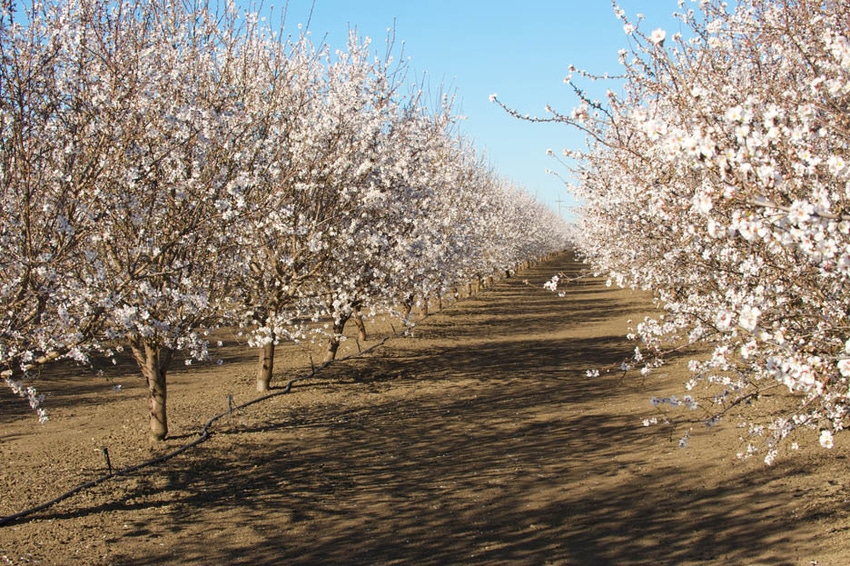
Following a mid-February start, the bloom in Don Cameron’s almond orchards south of Kerman, Calif., was all wrapped up by the end of the month — just before the arrival of welcomed rain, predicted to total about an inch or more.
Cameron is general manager for Terranova Ranches and Prado Farms, a 7,000-acre vegetable, wine grape and tree nut operation. The almond acreage includes 180 acres of mature Nonpareil and Monterey; 300 acres of third-leaf Nonpareil and Monterey that will be producing their first crop this season; 150 acres of Nonpareil, Monterey, and Wood Colony due to start production next season; and an 80-acre block of older Nonpareil, Butte and Carmel acquired this year.
Based on the warm weather in January, he had expected his trees to start blooming earlier than they did. “The bloom started on time and the flowers were a nice size,” he says. “The Monterey bloom looked excellent, better than the Nonpareil, which was slightly off. The bloom on the young trees was strong. However, the older blocks of Butte and Carmel, which were short of water last year, were slow to bloom and were still catching up with bloom when the rains came.”
Driving around his area he saw a lot of variation in this year’s bloom. It wasn’t unusual to see every fourth row of trees either lagging behind or not yet starting to bloom, he says. “It seemed like one of the pollinators wasn’t in sync with the Nonpareil this year,” Cameron adds. “Anyone with fields that were short of water last fall probably had a lighter, more variable bloom this time.”
Unlike a flash bloom of some years, this bloom was more spread out, he notes. That likely helped boost pollination rates. In his case, the weather and the bees were also doing their part.
Throughout the bloom his orchards enjoyed ideal weather, with temperatures one day reaching 76 degrees
“The bees were bubbling out of the hives,” he says. “They just loved it.”
He places about one hive per acre in his younger trees and stocks his older, more productive trees at rate of 2.5 to 3 hives per acre. The bees are supplied by a Florida beekeeper who has been able to keep pace with Cameron’s increasing need for bees as production in his relatively young orchards has increased over the past six years. The rental rate of the bees this year was up slightly from last year, he reports.
“I’m really happy with the quality of the bees,” Cameron says. “I’m guaranteed 10 frames per hive, but usually get around 14. I pay a little more for them, but I always get really strong hives.”
Groundwater reliance
The majority of his crop was set and all his trees were protected with fungicides and fed nutrients prior to the late February rainfall, he notes.
He began his bloom sprays early in the third week of February. He treated every other row of tree with fungicides, targeting brown rot, his primary disease threat at this point in the season, and shot hole. He also put on boron, calcium and an application of zinc to complement a zinc treatment last fall to hasten leaf drop. He sprayed the remaining tree rows the last week of February. “We pushed hard to get everything on and to get a good application right before the rain,” Cameron says. “We got a good coverage with the first application, but then came back on the other row to reinforce what we sprayed the first time through.”
Due to dry weather and cold temperatures in late fall and early winter and the risk of burning the buds on his trees, Cameron delayed his dormant sprays for peach twig borer and navel orangeworm until just before the start of bloom. That’s when his orchards received about three-quarters of an inch of rain. He combined an insecticide with oil to improve the efficiency of the insecticide. “I was a little hesitant to spray until the trees got some moisture back into them,” Cameron says. “The trees didn’t suffer any damage and we were able to treat them before the bees came in.”
All of his trees are on drip systems. However, with no available surface water to irrigate his orchards for the past two seasons, he’s relied solely on groundwater to keep in trees in good condition. Because of the dry, cold weather, he put much more water on his fields this winter than usual. He filled up the soil profile in late November and again in mid-January. That paid off in the form of healthy trees when the bloom started.
“Fortunately, we have the wells and good quality groundwater to do that,” he says. “Usually, we have a lot of fog during the winter, which helps keep the trees moist. This year we had none, whatsoever. I was really concerned. I’ve never seen a winter like this one.”
More from Western Farm Press
What happens if US loses California food production?
About the Author(s)
You May Also Like




